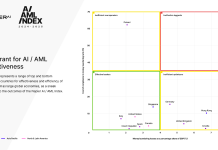In a world that is becoming more digitalised, financial crime is growing to become an even bigger challenge than in the past, with new avenues opened for threat actors.
In a recent post by RegTech firm Flagright, the company explored how a data-driven approach can help in the fight against financial crime, with the use of technologies such as machine learning and analytics.
With the rise of new and exciting technologies, comes the ability for such technologies to be abused for bad causes. To deal with this, Flagright believes a data-driven approach can help identity suspicious activities and prevent them before they occur.
Flagright said, “There is a lot of information that can help us figure out what is normal and what isn’t when it comes to transactions. This information is part of the huge amount of data that is generated every day by both financial institutions and government agencies.
“Having access to this data and being able to tell the difference between them is important for making technology that can accurately spot patterns of financial crime.”
What is financial crime? Often the definitions are wide-ranging, but to simplify it, they are generally acknowledged to include offenses such as fraud, money laundering, terrorist financing, cybercrime, insider trading and bribery and corruption.
To combat this, a data-driven approach can include the use of technology such as machine learning and analytics to detect suspicious activities, monitor transactions, and identify potentially fraudulent activity.
This strategy, Flagright highlights, provides organisations with a range of benefits, such as improved security, compliance and transparency. It is key for companies to understand the complexities of financial crime and have such a strategy in place to protect themselves against it.
Financial institutions in the past would rely on manual and human intervention in the regulatory reporting process. However, with huge amounts of data coming in and out of financial institutions, many individuals are unable to keep up with the demand.
To automate and accelerate a significant portion of such cumbersome work, AI, ML, NLP and cognitive automation can be used. This helps lower operational costs and free up people to focus on preventative interventions.
Flagright commented, “In addition to reducing operational workloads in case management, compliance teams are leveraging advanced analytics in a variety of preventative financial crime use cases, such as monitoring transactions in real-time, enriching the KYC process, improving sanctions screening performance, and assisting in the proactive identification of risks and opportunities.”
The company remarked that it is clear that financial institutions are being challenged both internally and externally in order to meet the demands of mitigating financial crime risks.
It went on, “To align operational effectiveness with these demands, financial institutions need to look for creative solutions to issues such as transaction monitoring, false positive rates, KYC due diligence, and screening alert management.
“Financial institutions are increasingly willing to go beyond simply flagging suspicious activity for compliance purposes. The goal is to use data and technology to identify potential criminal behaviour more cost-effectively and prevent criminal activity from occurring in the first place.
“Complete and accurate data is required to resolve these issues, and an improvement in data quality will have an immediate impact on the performance of existing monitoring and screening engines.
“AI, machine learning, and automation, among other advanced analytics and cognitive techniques, can help filter out false positives and improve inefficiencies in existing investigative processes. Data and analytics have the potential to not only drive efficiencies and operational cost reductions, but also identify intelligence-led and data-driven ways to combat financial crime.”
Find the full post here.
Copyright © 2023 FinTech Global











